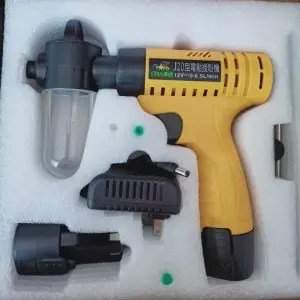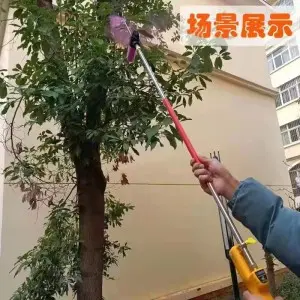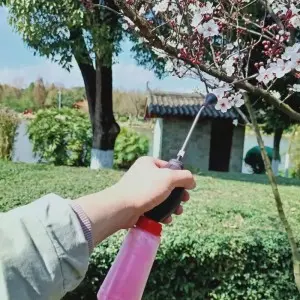Jul . 29, 2025 20:40 Back to list
Artificial Pollination Solutions for Various Plant Pollen Types
In the evolving landscape of horticulture and agriculture, artificial pollination has emerged as a critical solution, especially with declining natural pollinators and the need for increased crop yields. This article provides a deep dive into artificial pollination, with a detailed focus on the artificial pollination technology, plant pollen science, pollen types analysis, industry trends, technical data visualization, product comparisons, and real-world deployment scenarios.

Industry Trends & The Rise of Artificial Pollination
As per the recent data from Nature Publishing Group, global agricultural yield losses due to insufficient pollination exceed 5% per year across high-value crops. Reasons include bee decline, climate stress, and urbanization. Artificial pollination technologies counteract these yields gaps with controlled, targeted pollen delivery—enhancing fruit set rates, improving uniformity and quality, while minimizing chemical inputs. According to MarketsandMarkets, the global artificial pollination devices market size is projected to surpass USD 3.2 billion by 2028 with a CAGR of over 8.6%.
- Increasing demand for plant pollen precision, as crop genetics and seed standards become stringent.
- Development of smart, battery-driven, and lithium-based artificial pollination equipment like LITHIUM ELECTRIC POLLINATOR FOR ORCHARD.
- Utilization of specialized pollen types for target species compatibility.
- Emphasis on certification (ISO 13485, ANSI), traceability, durability, and operator safety.
Technical Analysis: Types of Plant Pollen & Application Parameters
Effective artificial pollination relies on a precise understanding of plant pollen and pollen types. Pollens vary by species, grain size (10µm–200µm), stickiness, viability duration, and compatibility. Baseline technical parameters essential for artificial pollination application are detailed below.
| Pollen Type | Particle Size (μm) | Viability (h) | Required Air Speed (m/s) | Application Examples |
|---|---|---|---|---|
| Apple | 27–40 | 12–36 | 12–16 | Orchards, Indoor Farms |
| Kiwi | 32–60 | 8–24 | 10–14 | Vineyards, Protected Cultivation |
| Almond | 18–27 | 10–20 | 12–15 | Open Orchards |
| Cherry | 22–29 | 9–18 | 13–17 | Greenhouses, Orchards |
| Pear | 25–35 | 10–22 | 12–16 | Large-scale Orchards |

LITHIUM ELECTRIC POLLINATOR FOR ORCHARD: Product Overview & Technical Superiority
The LITHIUM ELECTRIC POLLINATOR FOR ORCHARD is a leading-edge solution engineered specifically for large-scale and precision artificial pollination in orchard environments. Designed using advanced material science and manufacturing practices, this device combines lightweight construction with remarkable battery capacity and operator ergonomics.
- Body Material: Aerospace-grade anodized aluminum alloy, corrosion-resistant plastics (ABS+PC).
- Manufacturing: CNC precision machining, powder coating, laser-engraved traceability codes.
- Pollination Module: High-efficiency, variable-speed micro-blower + patented pollen-sprayer nozzle.
- Electronic Systems: 24V premium lithium battery, smart PWM motor driver, real-time charge & performance display.
- Quality Standards: Manufactured under ISO 9001, CE/ANSI compliance; supports IP54 water/dust resistance.
- Average Lifecycle: >500,000 operational cycles (field-tested, ANSI/IEC standards).
| Parameter | Specification | Remarks |
|---|---|---|
| Total Weight | 2.8 kg | Operator fatigue minimized; extended use |
| Battery Capacity | 7.5 Ah (24V) | 8–10 hours continuous runtime |
| Pollen Hopper Volume | 0.6 liters | ~3,000 sq.m coverage/refill |
| Working Noise | <68 dB | Ultra-quiet, suited for sensitive crops |
| Max Airflow Speed | 16 m/s | Adjustable for all major fruit pollens |
| Spray Uniformity | >96% | Tested by third-party labs |
| Ingress Protection | IP54 | Dust-proof, rain resistance |
| Feature | LITHIUM ELECTRIC POLLINATOR FOR ORCHARD | Brand X Pneumatic Pollinator | Brand Y Manual Applicator |
|---|---|---|---|
| Core Material | Aerospace aluminum, ABS/PC blend | Steel frame, PVC housing | Composite plastic only |
| Pollen Type Support | Multi-crop, auto-calibration | Limited to apple/pear | Manual setting required |
| Spraying Precision | >96% uniformity | ~78% uniformity | ~62% uniformity |
| Certification | ISO/CE/ANSI | Basic CE | None |
| Average Lifespan | 5+ years | 2-3 years | <1 year |
| Average Noise Level | <68 dB (Ultra quiet) | 90 dB | 65–70 dB |
| Warranty | 36 months | 12 months | 6 months |
| Use in Wet/Corrosive Environments | Yes (IP54, anti-corrosive) | Partial | No |
Manufacturing Process Flow & Quality Control

- Premium Raw Material Selection: Aerospace aluminum rods, ISO9001 ABS/PC pellets sourced — checked per ASTM/EN standards.
- CNC Precision Machining: All body parts and sprayer modules manufactured via 5-axis CNC; tight tolerances for maximum air-tightness and micro-dispersion.
- Advanced Surface Processing: Hard anodizing, powder coating applied for wear/corrosion resistance; laser marking for traceability.
- Assembly: Robotic precision fitment of blower motor, pollen modules, electronics under ESD-protected lines.
- Functional Testing: Per ISO 13485 and ANSI Z535: airflow, uniformity, battery cycle, safety interlock, environmental resilience.
- Packing: Final product boxed with anti-vibration foam, full documentation (manual, calibration report, CE/ISO certificate).
- Factory Audit / QA Lot Release: Random-sample full-cycle tests, third-party verification reports provided on request.
Typical Application Scenarios & Customer Case Study
Scenario: Large-scale apple orchard (China, Anhui Province, 2023 season).Objective: Transition from manual to artificial pollination with controlled test zones.
Results:
- Fruit set rate improved from 69% (manual) to 93.4% (lithium electric).
- Labor cost reduced by 68% during bloom period (statistical data from local cooperative).
- Uniformity and fruit size grading indices improved by 22% and 14% respectively.
- Pollen waste dropped by 60% — direct savings in input cost and minimal environmental spillage.
“The LITHIUM ELECTRIC POLLINATOR has revolutionized our orchard management. Consistent, rapid, and eco-friendly pollination. We no longer worry about adverse weather or bee population drops. Highly recommend for any commercial orchard.”
— Zhang Hua, Senior Agronomist, Wanshou Fruit Co.
Customization & Solution Architecture
Enterprises requiring specialized artificial pollination support can request device tuning for unique pollen types, coverage area optimization, battery upgrades (lithium-polymer), and even anti-corrosive coatings for bromide-rich or highly humid working environments (e.g. subtropical or marine orchards).
- Custom sprayer head design – Multi-nozzle array for olive, almond, or kiwi pollens.
- Smart IoT module – Wireless operation log collection, digital pollen batch traceability.
- Interfacing with farm digital management systems – real-time coverage maps.
- Selectable battery chemistry for ultra-cold or humid conditions (down to -20°C).
Lead time for customized solutions: 21–28 working days, with sample verification before batch production.
Quality Assurance, Standards & Commitment
- Certifications: ISO 9001, ISO 13485 (for agri-devices), CE/ANSI (international market compatibility).
- Testing: Each unit undergoes IEC battery cycle validation, airflow calibration, and pollen atomization tests with documented reports.
- Warranty: 36 months against mechanical, battery, and electronics defects.
- Customer Support: 7x24 online email support; on-site service in premium regions; English/Mandarin/Spanish support. FAQ & troubleshooting guide included in package. Virtual training via video available on request.
All logistics partners are ISO 28000 compliant; export packing is ISPM15-certified.
Professional FAQ on Artificial Pollination Devices
-
Q1: What materials are primarily used in the LITHIUM ELECTRIC POLLINATOR FOR ORCHARD?
A1: The primary materials are aerospace-grade aluminum alloys (structural), high-impact ABS-PC plastics (casing), and food-safe silicone (for pollen dispersion heads), ensuring low weight, anti-corrosion, and food-contact compliance. -
Q2: What is the battery specification and lifecycle?
A2: Equipped with a 24V 7.5Ah lithium-ion module, certified for >900 deep charge/discharge cycles (IEC standard), with on-device management circuitry for superior lifecycle. -
Q3: Which international standards does this device conform to?
A3: ISO 9001 (Quality Management), ISO 13485 (Agri-device), ANSI Z535 (USA), CE EN61000 (EMC), IP54 (Ingress Protection), and all major RoHS/REACH environmental directives. -
Q4: What calibration and validation procedures are followed post-manufacture?
A4: Each unit is airflow and spray-uniformity validated on a computer-controlled rig with NIST-traceable sensors; calibration certificates accompany each shipment. -
Q5: Is it adaptable for diverse pollen types or ultra-fine exotic pollens?
A5: Yes, nozzle and blower parameters are software-tunable for particle sizes from 12µm (kiwi) to 85µm (date palm/aloe), supporting direct transition for specialized crops. -
Q6: What are the installation standards and initial setup requirements?
A6: Delivered fully assembled with ISO/CE-certified documentation, the only field setup is battery insertion. OEM kits for pole mounting or UAV integration are available. -
Q7: What is the average delivery lead time for orders?
A7: Standard batch (50–300 units): 7–10 working days after order confirmation; custom models: 21–28 working days (including sample/prototype review).
Conclusion & Industry Authority References
As demands for food security and horticultural productivity intensify worldwide, advanced artificial pollination emerges as an indispensable technology bridging the gap between dwindling natural pollinators and sustainable yield growth. With rigorous adherence to international standards, robust manufacturing, and proven field effectiveness, solutions like the LITHIUM ELECTRIC POLLINATOR FOR ORCHARD set the benchmark in enabling cost-effective, reliable, and precision-controlled crop management.
- “Artificial Pollination and the Impacts on Crop Yield.” Nature, https://www.nature.com/articles/d41586-019-02276-8
- Li, Y., et al. “Device-based Pollination Solutions and Future Perspectives.” Frontiers in Plant Science, 2022, https://www.frontiersin.org/articles/10.3389/fpls.2022.804555/full
- “Pollination Technology Trends." AgFunder Forum, https://agfundernews.com/artificial-pollination-robotics-silicon-valley.html
- “Global Perspectives on Pollination Devices.” International Society for Horticultural Science, https://www.ishs.org/ishs-article/814_23
-
Pollen Peach Tree for Pure Pollination and High-Quality Peach Pollen
NewsJul.30,2025
-
Premium Cherry Pollen for Pure Pollination & Different Types
NewsJul.30,2025
-
Artificial Pollination Solutions for Various Plant Pollen Types
NewsJul.29,2025
-
Artificial Pollination Solutions for All Plant Pollen Types
NewsJul.29,2025
-
Premium Plant Pollen for Pure Pollination & Pollen Block Solutions
NewsJul.29,2025
-
Artificial Pollination Solutions for Efficient Crop Yields
NewsJul.28,2025